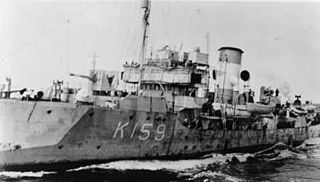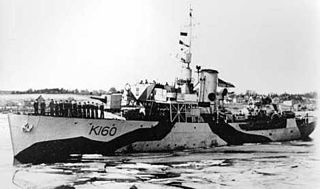
HMCS Buctouche was a Flower-class corvette that served in the Royal Canadian Navy (RCN) during the Second World War. She served primarily in the Battle of the Atlantic as a convoy escort. She was named for Bouctouche, New Brunswick.

HMCS Snowberry was a Flower-class corvette that was originally built for the Royal Navy, but spent most of the war in service with the Royal Canadian Navy. She fought primarily as a convoy escort during the Second World War. She served primarily in the Battle of the Atlantic.

HMCS Regina was a Royal Canadian Navy revised Flower-class corvette which took part in convoy escort duties during the Second World War. She fought primarily in the Battle of the Atlantic. She was named for Regina, Saskatchewan.

HMCS Halifax was a Royal Canadian Navy revised Flower-class corvette which took part in convoy escort duties during the Second World War. She served primarily in the Battle of the Atlantic. She was named for Halifax, Nova Scotia.

HMCS Brantford was a Flower-class corvette that served in the Royal Canadian Navy during the Second World War. She served primarily as a convoy escort in the Battle of the Atlantic. She was named for Brantford, Ontario.

HMCS Napanee was a Flower-class corvette of the Royal Canadian Navy during the Second World War. She saw service primarily in the Battle of the Atlantic as a convoy escort. She is named after Napanee, Ontario.

HMCS Shediac was a Flower-class corvette of the Royal Canadian Navy during the Second World War. She served primarily in the Battle of the Atlantic as a convoy escort. She was named after the town of Shediac, New Brunswick.

HMCS Collingwood was a Flower-class corvette that served with the Royal Canadian Navy during the Second World War. She served primarily in the Battle of the Atlantic though also saw service as a training vessel. She was named for Collingwood, Ontario.

HMCS Dunvegan was a Flower-class corvette that served with the Royal Canadian Navy during the Second World War. She served primarily in the Battle of the Atlantic. After the war she was sold to the Venezuelan Navy. She was named for Dunvegan, Inverness County, Nova Scotia.

HMCS Hepatica was a Flower-class corvette that served primarily with the Royal Canadian Navy during the Second World War. She saw service in the Battle of the Atlantic as an ocean escort. Originally commissioned into the Royal Navy, she was loaned to Canada in 1941.

HMCS Chicoutimi was a Flower-class corvette that served with the Royal Canadian Navy during the Second World War. She served primarily in the Battle of the Atlantic as an ocean escort. She was named for Chicoutimi, Quebec.

HMCS Lethbridge was a Flower-class corvette that served with the Royal Canadian Navy during the Second World War. She served primarily in the Battle of the Atlantic as an ocean escort. She was named for Lethbridge, Alberta.

HMCS Saskatoon was a Flower-class corvette that served with the Royal Canadian Navy during the Second World War. She saw service primarily in the Battle of the Atlantic. She is named for Saskatoon, Saskatchewan.

HMCS Sherbrooke was a Flower-class corvette that served with the Royal Canadian Navy during the Second World War. She served primarily in the Battle of the Atlantic as an ocean escort. She is named for Sherbrooke, Quebec.

HMCS The Pas was a Flower-class corvette that served with the Royal Canadian Navy during the Second World War. She served primarily as an ocean escort in the Battle of the Atlantic and as a training ship. She was named for The Pas, Manitoba.

HMCS Ville de Québec was a Royal Canadian Navy revised Flower-class corvette which took part in convoy escort duties during the Second World War. She fought primarily in the Battle of the Atlantic. She was named for Quebec City, Quebec. Following the war, the ship was sold to commercial interests, in service until 1952.

HMCS New Westminster was a Flower-class corvette that served with the Royal Canadian Navy during the Second World War. She saw action primarily in the Battle of the Atlantic. She was named for New Westminster, British Columbia.

HMCS Vancouver was a Flower-class corvette that served with the Royal Canadian Navy during the Second World War. She saw action primarily in both Atlantic and Pacific theatres. She was named for Vancouver, British Columbia. She was the second commissioned ship and the third overall to bear the name Vancouver.

HMCS Port Arthur was a Royal Canadian Navy revised Flower-class corvette which took part in convoy escort duties during the Second World War. She fought primarily in the Battle of the Atlantic. She was named for Port Arthur, Ontario.

HMCS Owen Sound was a modified Flower-class corvette that served with the Royal Canadian Navy during the Second World War. She fought primarily in the Battle of the Atlantic as a convoy escort. She was named for Owen Sound, Ontario.




















